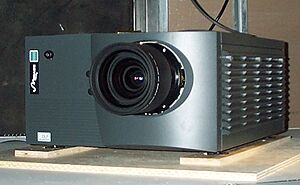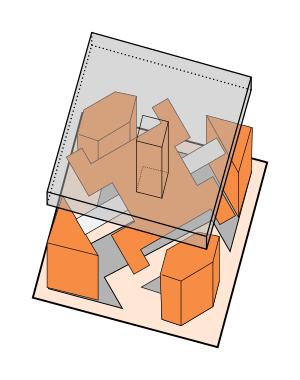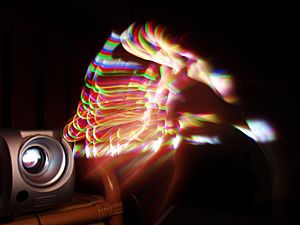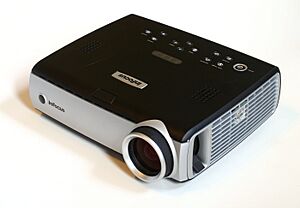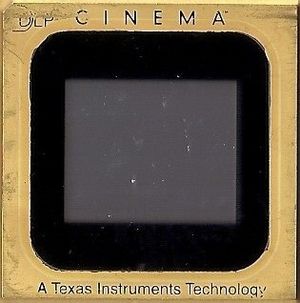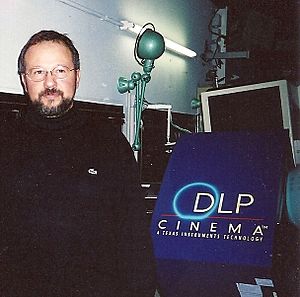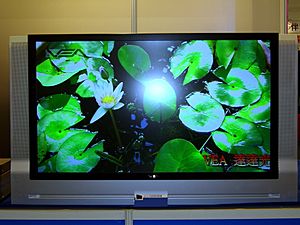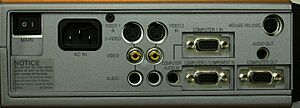Digital Light Processing facts for kids
Digital Light Processing (DLP) is a special technology that uses tiny mirrors to create images. It's based on a type of micro-electro-mechanical system. This technology was first created in 1987 by Larry Hornbeck at Texas Instruments.
Even though Texas Instruments invented the core technology, the first projector using DLP was made by Digital Projection Ltd in 1997. Both companies won Emmy Awards in 1998 for this amazing invention.
DLP is used in many different display devices. You can find it in regular projectors for classrooms and businesses. It's also in some television sets and digital signs. About 85% of digital cinema projectors use DLP. It even helps in additive manufacturing, like 3D printers, to harden special resins.
Smaller DLP chips, called "pico" chipsets, are found in mobile devices. These include phone accessories and even projection features built right into some phones.
Contents
How DLP Works
The Digital Micromirror Device (DMD)
In DLP projectors, the image is made by super tiny mirrors. These mirrors are arranged in a grid on a special computer chip called a digital micromirror device (DMD). Each mirror is incredibly small, sometimes less than 5.4 micrometers wide.
Every tiny mirror creates one or more pixels in the picture you see. The number of mirrors matches the picture's resolution. Common DMD sizes include 800x600, 1024x768, and 1920x1080 (which is HDTV).
These mirrors can tilt very quickly. They either reflect light through the projector's lens or away from it. When a mirror reflects light through the lens, that part of the screen becomes bright. When it reflects light away, that part becomes dark. By quickly switching a mirror between "on" and "off," the projector creates different shades of grayscale. The longer a mirror is "on," the brighter that spot appears.
How DLP Creates Color
DLP projection systems make color images in two main ways. One way is for projectors with a single DLP chip. The other is for projectors with three DLP chips. A third method uses colored LEDs, which is newer.
Single-Chip Projectors
 |
 |
 |
 |
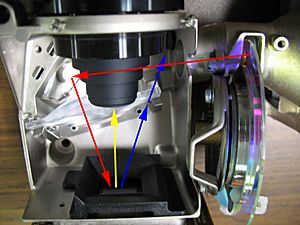 |
|||
| Inside a single-chip DLP projector. Light goes through a spinning color wheel, then hits the DMD. The DMD reflects light either into the lens or into a "light-sink." | |||
Projectors with one DLP chip create colors using a spinning color wheel. This wheel sits between the white lamp and the DLP chip. The color wheel has sections of different colors, usually red, green, and blue. Some wheels also have a clear (white) section. Newer systems might use cyan, magenta, and yellow too.
The DLP chip works in sync with the color wheel. When the green section of the wheel is in front of the lamp, the chip shows the green parts of the image. The same happens for red, blue, and other colors. The colors flash very quickly, one after another. Our eyes combine these fast-flashing colors into a single, full-color picture. Older models showed one color rotation per frame. Now, most systems rotate the colors up to 10 times faster than the frame rate.
The "Rainbow Effect"
Some DLP projectors that use a spinning color wheel can show something called the "rainbow effect." This looks like quick flashes of red, blue, and green "shadows." You might see it when a bright object moves quickly across a dark background. For example, it can happen during movie credits or with cartoons that have thick black outlines.
This effect happens because your eye follows a moving object. But the projector shows each color of the image in the same spot, one after another. So, as your eye moves, it sees the red part of the image slightly shifted. Then it sees the green part shifted again, and the blue part shifted even more. This makes it look like a tiny rainbow.
Not everyone sees this effect. Some people notice it often, while others never do. Newer projectors that use LEDs or lasers instead of a lamp and color wheel usually don't have this problem. This is because LEDs and lasers can switch colors much faster without needing a spinning wheel. Three-chip DLP projectors also don't have this effect because they don't use a color wheel.
Three-Chip Projectors
A three-chip DLP projector works differently. It uses a prism to split the light from the lamp into three primary colors: red, green, and blue. Each of these colors then goes to its own separate DMD chip. After each chip creates its part of the image, the colors are combined again. Finally, the full-color image is sent out through the lens.
These three-chip systems are found in high-end home theater projectors. They are also used in large event projectors and in most digital movie theaters. According to DLP.com, these projectors can create an incredible 35 trillion colors. This means they can show a very wide range of colors.
Light Sources for DLP
DLP technology can work with many different kinds of light sources. For a long time, the main light source was a special high-pressure xenon arc lamp. These lamps need to be replaced after a certain number of hours. Smaller DLP projectors, often called "pico" projectors, usually use powerful LEDs or lasers for light. Since 2021, laser light sources have become very common in many professional projectors.
Xenon Arc Lamps
Xenon arc lamps need a special power supply to start. They use a very high voltage to create an arc of light between two electrodes. Once the light is on, the voltage drops, and the current increases to keep the light bright. As the lamp gets older, it becomes less efficient. This means it produces less light and more heat.
When a lamp is nearing its end, a light on the projector or a message on the screen will tell you it's time to replace it. Continuing to use an old lamp can make it even less efficient. It might also cause the light to become uneven. In some cases, a very old lamp can get so hot that its wires melt or the lamp itself can crack or explode. Projectors have safety features to prevent this, like heat-resistant barriers.
LED-Based DLPs
The first TV using LED-based DLP was the Samsung HL-S5679W in 2006. This TV didn't need a color wheel. LEDs have many benefits. They last a very long time, so you don't need to replace lamps. They also turn on instantly. Plus, they can create better colors with more vividness.
Special LEDs called PhlatLight LEDs are used in these TVs and in small "pocket projectors." These LEDs are powerful enough to replace traditional lamps. Companies like LG, Samsung, and Casio use them in their compact projectors.
Laser-Based DLPs
The first TV using laser-based DLP was the Mitsubishi L65-A90 LaserVue in 2008. Like LED-based systems, it also didn't need a color wheel. These TVs use three separate colored lasers to light up the DMD chip. This creates even richer and more vibrant colors than other methods. You can learn more about this in the laser video display article.
DLP in Digital Cinema
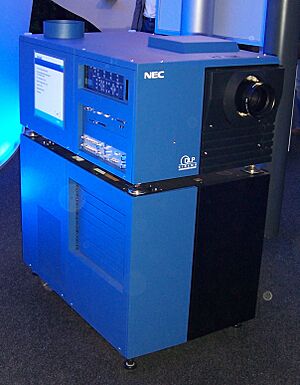
DLP Cinema systems have been used in movie theaters since 1999. In June 1999, Star Wars: Episode I – The Phantom Menace was the first movie to be fully scanned and sent to theaters digitally. Four theaters used digital projectors for its release. The animated film Tarzan also used this technology that same year. Later, Toy Story 2 was the first movie to be completely made, edited, and sent out digitally. More theaters installed digital projectors for its release.
DLP Cinema was the first widely used digital cinema technology. It is still the most popular, with about 85% of the world's digital movie screens using it by 2011. Digital cinema has advantages over traditional film. Film can fade, jump, scratch, and get dirty. Digital cinema keeps the movie looking perfect every time. Today, most movies are also filmed digitally. The first live-action movie filmed entirely without film was Star Wars Episode II: Attack of the Clones in 2002.
DLP Cinema doesn't make the projectors themselves. Instead, it provides the technology to companies like Barco, Christie Digital, and NEC, who then build the projectors. DLP Cinema projectors come in different resolutions. These include 2K for most screens, 4K for very large screens, and S2K for smaller theaters.
On February 2, 2000, Philippe Binant made the first digital cinema projection in Europe. He used DLP CINEMA technology at Gaumont in France. DLP is a leader in professional digital movie projection. This is because it offers high contrast and good resolution. By December 2008, over 6,000 DLP-based Digital Cinema Systems were installed worldwide.
DLP projectors are also used in RealD Cinema and newer IMAX theaters for 3-D films.
DLP in the Market
Since it first came out in 1996, DLP technology has become very popular. It now holds over 50% of the market for front projectors. It also has 85% of the digital cinema market and about 70% of the small "pico" projector market. More than 30 companies use DLP chips in their display systems.
Good Things About DLP
- Smooth Pictures: Images are very smooth, especially at high resolutions.
- Great Colors: It can create perfect shapes and excellent shades of gray.
- High Contrast: DLP usually has very good contrast, meaning deep blacks and bright whites.
- Longer Life: Because you can replace the light source, DLP displays can last longer than some other types of screens.
- Easy Lamp Change: The light source is often easy for users to replace.
- No Polarization: The light from DLP images is not naturally polarized.
- Newer Tech: New LED and laser DLP systems don't need lamp replacements at all.
- Affordable 3D: DLP offers affordable 3D projection from one device. It works with both active and passive 3D glasses.
- Lighter Weight: DLP TVs are lighter than LCD or plasma TVs.
- Big Screens: DLP screens aren't limited by liquid parts. This makes them great for very large theater screens.
- Wide Color Range: DLP projectors can process up to seven separate colors. This gives them a wider range of possible colors.
Things to Consider About DLP
- "Rainbow Effect": Some people are bothered by the "rainbow effect" in models with color wheels. This is more common in older projectors.
- Size: Rear-projection DLP TVs are not as thin as flat-panel LCD or plasma TVs. However, some newer models can be mounted on walls.
- Lamp Replacement: In lamp-based units, you need to replace the lamp. A lamp usually lasts 2,000 to 5,000 hours. Replacement lamps can cost between $99 and $350. Newer units use LEDs or lasers, which solve this problem.
- Color Wheel Noise: Some people find the high-pitched sound of the color wheel annoying. But many projectors are designed to be silent.
- Image Noise: You might notice some slight "dithering noise," especially in dark parts of the image. Newer chips have less noise.
- Gaming Lag: Sometimes, there can be a slight delay (input lag) when playing video games. This happens when the projector has to change a lower resolution signal to its own resolution. Newer game consoles with HD output usually don't have this problem if connected with HD cables.
- Viewing Angle: The picture might not look as good if you view it from a very wide angle. This is compared to TVs like CRT, plasma, or LCD.
- Power and Heat: DLP projectors can sometimes use more electricity and create more heat than other technologies.
DLP, LCD, and LCoS Rear Projection
A similar technology to DLP is called LCoS (liquid crystal on silicon). LCoS creates images using a mirror that stays still. It uses a liquid crystal screen, like an liquid crystal display, to control how much light is reflected. DLP-based TVs are generally thinner than older types of projection TVs.
See also
 In Spanish: Procesado digital de luz para niños
In Spanish: Procesado digital de luz para niños
- 3LCD
- Comparison of display technology
- Handheld projector
- Inflatable movie screen
- Large-screen television technology
- Laser video display
- Liquid crystal on silicon
- Organic light-emitting diode (OLED)
- Surface-conduction electron-emitter display (SED)



